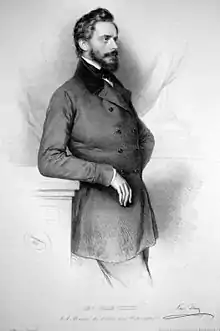Thun und Hohenstein
The Thun und Hohenstein family, also known as Thun-Hohenstein, belonged to the historical Austrian and Bohemian nobility. One branch of the family lived at Děčín (Tetschen), Bohemia, for more than 200 years.

History

A feudal family originally from Ton, Trentino, formerly an Italian speaking part of Tyrol, today part of the Trentino province of Italy, the male line traces back to Manfreinus of Tunno in 1187.[1] In 1469 they became hereditary Cup-bearers of the Prince-bishopric of Trento and in 1558 of the Prince-bishopric of Brixen.
Titles of Baron, Count and Prince
All males of the family were granted the title of Baron in 1604, and Counts of the Holy Roman Empire (Reichsgraf) in 1629. The title of Prince was conferred upon the head of the family, along with the style of Durchlaucht (Serene Highness), in the Austrian Empire in 1911.[1] They were hereditary members of the Austrian House of Lords, in right of possession of the entailed lordship of Tetschen since 1879.[1]
Properties in Bohemia
In 1621 the family acquired The Chateau at Klášterec nad Ohří, Bohemia, in 1629 Eulau Castle, expropriated in 1946, in the second half of the 17th century Děčín Castle (German: Tetschen), then the family's main seat until it was sold in 1932. Later they also acquired Choltice Castle and Benátky nad Jizerou Castle, and several palaces in Prague.
Notable family members
Friedrich von Thun und Hohenstein
Of the three sons of Count Franz Anton (1786–1873) and his wife Countess Theresia Anna Maria (née von Brühl), the eldest, Friedrich von Thun und Hohenstein (1810–1881), entered the diplomatic service. After holding other posts he was in 1850 appointed president of the restored German Diet at Frankfurt, where he represented the anti-Prussian policy of Prince Felix Schwarzenberg, and often came into conflict with Prince Bismarck, who was the Prussian envoy. He was afterwards ambassador at Berlin and St. Petersburg. After his retirement in 1863 from the public service in the Bohemian Landtag and the Austrian Reichsrat he supported the federal policy of his brother Leo. In 1879 he was made a hereditary member of the Upper House. In this position he was, on his death 24 September 1881, succeeded by his eldest son Franz (born 1847).
Maria Wilhelmine von Thun und Hohenstein
Countess Maria Wilhelmine von Thun und Hohenstein, née Countess von Ulfeldt was a Viennese aristocrat of the 18th century. She was the hostess of a musically and intellectually outstanding salon, and a patroness of music, notably that of Mozart and Beethoven.
Leopold von Thun und Hohenstein
Count Leopold von Thun und Hohenstein (1811–1888) was a leading Austrian statesman who was later a minister in the cabinets of Schwarzenberg and Bach.
Franz Anton von Thun und Hohenstein
Count Franz Anton von Thun und Hohenstein, Czech: hrabě František Antonín z Thunu a Hohensteina (1847–1916) was an Austro-Hungarian nobleman and statesman. He was Governor of his native Bohemia from 1889 to 1896 and again from 1911 to 1915. He was elevated to princely rank by Emperor Franz Joseph I of Austria on 19 July 1911. Leaving no sons, he was succeeded in the princely title by his brother Jaroslav (1864-1929).[1]
Galeazzo von Thun und Hohenstein
Fra' Galeazzo von Thun und Hohenstein (1850–1931) was the 75th Prince and Grand Master of the Sovereign Military Order of Malta from 1905 to 1931.
Róża Maria von Thun und Hohenstein
Róża Maria Gräfin von Thun und Hohenstein (née Woźniakowska, born 13 April 1954), usually shortened to Róża Thun, married Franz Graf von Thun und Hohenstein in 1981. She is a European Parliament Member (MEP) from Poland since 2009.
Other prominent members
- Johann Ernst von Thun und Hohenstein (1643–1709), prince-archbishop of Salzburg from 1687 to 1709
- Friedrich von Thun, Austrian actor
- Max von Thun, Austrian actor
Historic Property
 Děčín (Tetschen) Castle, Czech Republic
Děčín (Tetschen) Castle, Czech Republic Klášterec nad Ohří (Klösterle) castle
Klášterec nad Ohří (Klösterle) castle Choltice castle
Choltice castle Benátky nad Jizerou castle
Benátky nad Jizerou castle Jílové u Děčína (Eulau) castle
Jílové u Děčína (Eulau) castle Thun-Hohenstein Palace, Prague (Malá Strana)
Thun-Hohenstein Palace, Prague (Malá Strana) Thun-Palace, Prague
Thun-Palace, Prague Thun Palace, Prague
Thun Palace, Prague
References
- Almanach de Gotha, Thun und Hohenstein. Justus Perthes, 1944, p. 539. French.
 This article incorporates text from a publication now in the public domain: Headlam, James Wycliff (1911). "Thun-Hohenstein". In Chisholm, Hugh (ed.). Encyclopædia Britannica. 26 (11th ed.). Cambridge University Press. pp. 898–899.
This article incorporates text from a publication now in the public domain: Headlam, James Wycliff (1911). "Thun-Hohenstein". In Chisholm, Hugh (ed.). Encyclopædia Britannica. 26 (11th ed.). Cambridge University Press. pp. 898–899.
External links
 Media related to Thun-Hohenstein at Wikimedia Commons
Media related to Thun-Hohenstein at Wikimedia Commons
